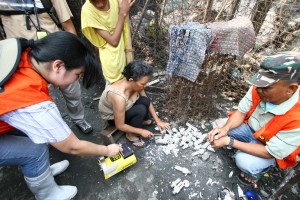
Environmentalist urged to observe proper toxic waste disposal in Tondo, Manila after they have detected toxic vapors, specifically mercury vapor, near the port area.
The investigation was conducted by the environmental group Ban Toxics, Global Alliance Incinerator Alternatives, Health Care Without Harm and the EcoWaste Coalition last April 19. The result shows the present of Mercury Vapor coming from lamp waste recycling stations of the pier 18, Garbage Transfer Station.
The group explained in a statement that they have used a hand-held ambient air analyzer to detect whether there are mercury vapor in the sites where the breaking of compact fluorescent lamp is conducted.
14 used CFL was used by the group as sample coming from two different sites. Each one was tested and the group has recorded 117.20 micrograms per cubic meter (mcg/m3), with one product registering mercury vapor of 502.40 mcg/m3.
According to group the allowable exposure of mercury vapor in the environment is only 100 mcg/m3, this is based on the standard set by the US Occupational Safety and Health Administration.
EcoWaste Coalition Thony Dizon, chemical safety project coordinator warned that not only the workers or lamp waste recyclers in the site will bear the negative effect for the mercury vapor escapes as the gl(–foul word(s) removed–) tubing is broken and travels around, which exposes the workers in the site, their children and the environment.
To further explain the hazardous effect of mercury vapor to human. The group cite the book “Mercury-Containing Lamp Waste Management” where in it t explains that when a person exposed to high level of mercury vapor it may result to the following conditions; permanent brain damage, central nervous system disorders, memory loss, heart disease, kidney failure, liver damage, vision loss, sensation loss, and tremors.
They have also reminded the people that mercury-containing C FL should be properly disposed and should be handled separately from the regular waste.
Dizon said that the data they have gathered should serve as a warning signal to the government and business officials to impose a mercury pollution prevention measures such as a practical system for collecting lamp waste and ensuring their safe management.
The group held the testing as part of the celebration of Earth Day last April 22 and the World Day for Safety and Health at Work on April 28.
